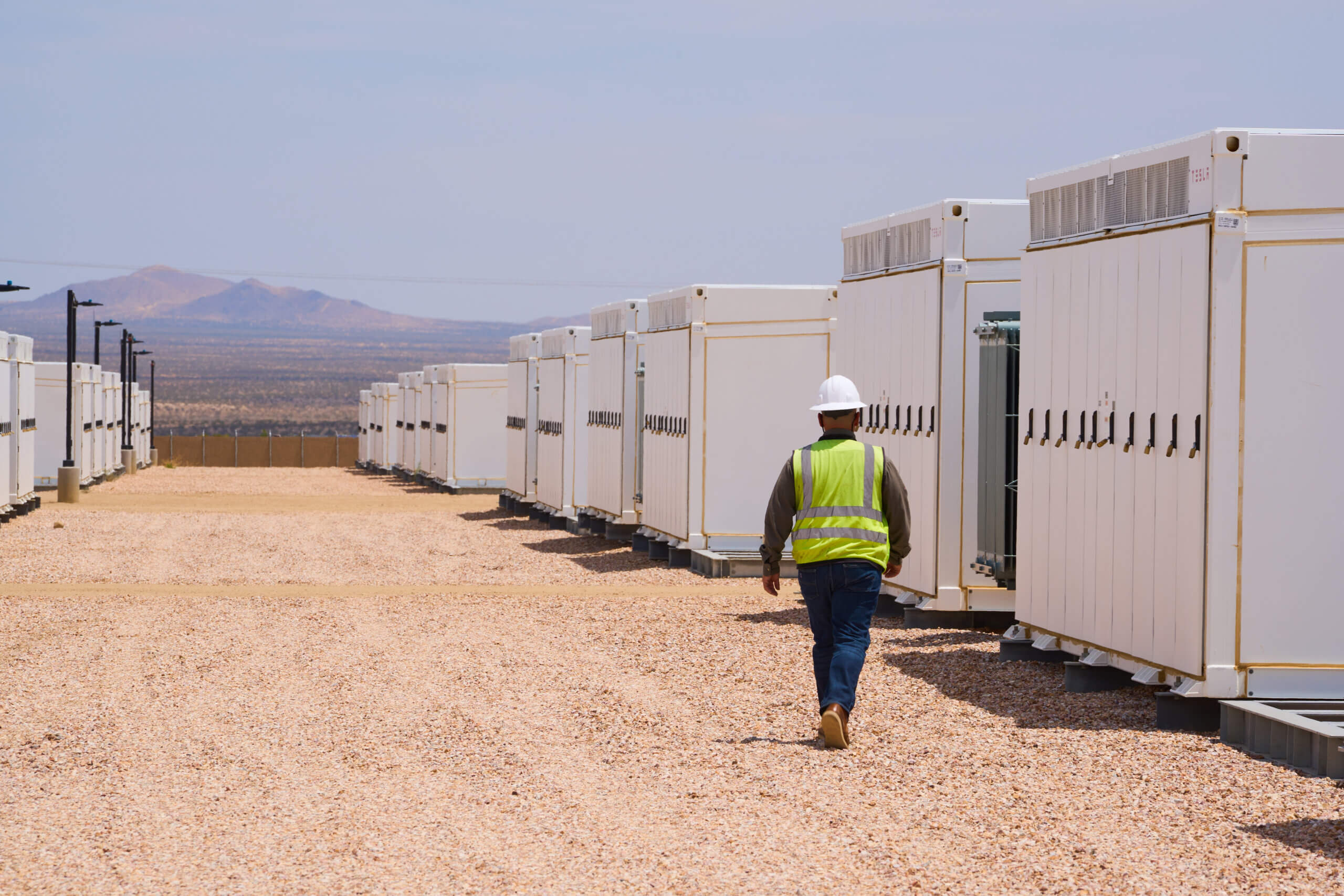March 13, 2025
How Does Utility-Scale Battery Storage Work?
Utility-scale batteries store electricity and strategically discharge it when needed most. Learn how battery storage systems work.

Utility-scale energy storage plays a crucial role in balancing supply and demand in the U.S. power grid, especially as renewable energy sources like solar become more prevalent. By capturing surplus electricity and discharging it when it’s needed most, battery energy storage systems (BESS) stabilize the grid, improve reliability, and maximize the use of renewable power.
Here’s how battery storage works, and how this critical technology is modernizing America’s aging electrical system.
How Does Battery Storage Work?
Utility-scale battery storage converts electricity into chemical energy, stores it, and later releases it as needed. When discharged, the stored energy is converted back into usable electricity and delivered to homes and businesses.
Standalone Battery Storage
Standalone battery storage systems can store energy from renewable as well as non-renewable sources. Standalone batteries are charged from the electric grid and are not physically co-located with a utility-scale solar project. These independent systems respond to overall grid conditions to provide critical grid level or distribution level services.
Co-Located Battery Storage
Co-located battery storage systems are installed alongside renewable generation sources like utility-scale solar projects, improving project efficiency and often reducing expenses by sharing system costs. Co-located energy storage systems can be either direct current (DC) or alternating current (AC) coupled.
DC coupled systems are more common for new solar-plus-storage facilities. DC coupled systems directly charge batteries with the DC power generated by solar photovoltaic (PV) panels.
AC coupled configurations are typically used when adding battery storage to existing solar PV systems, as they are easier to retrofit. AC coupled systems require an additional inverter to convert the solar electricity from AC back to DC in order to charge the batteries. In this configuration, the batteries can act independently from the solar PV system.
Battery Storage Components

Battery storage systems consist of large battery racks housed in shipping containers, outdoor-rated enclosures, or purpose-built structures. They are placed strategically along transmission lines, in rural or urban areas, where they can efficiently store and dispatch energy. There are six key components that enable batteries to accomplish this. Here’s how each part contributes to overall system functionality:
- Battery modules: Modules consist of interconnected Lithium Iron Phosphate (LFP) battery cells that store and release energy. Modules can be stacked together to create a battery rack.
- Battery management system (BMS): The BMS monitors and manages battery health and safety.
- Battery enclosure: The enclosure, where battery racks are installed, is noncombustible, weatherproof, and UL-rated. The enclosure is equipped with a thermal management system to maintain battery temperature ranges. The system automatically shuts down if an elevated temperature is reached.
- Power conversion system (PCS): A PCS, also referred to as a bi-directional inverter, facilitates the process of converting DC electricity to AC electricity to discharge it to the grid. The inverter also converts AC to DC energy to charge the batteries.
- Energy management system (EMS): The EMS optimizes performance and communicates with the PCS to direct the flow of energy in and out of the system.
- Supervisory control and data acquisition (SCADA) system: SCADA works with the EMS 24/7 to enable real-time monitoring, control, and data acquisition of the battery system for reliable and safe energy management.
Valuable Electrical System Services
Utility-scale battery systems respond in real time to grid conditions, delivering critical services at both the grid and distribution levels.
Energy Services
Our energy storage facilities optimize grid performance, enhance reliability, and reduce costs by efficiently managing energy supply and demand.
- Capacity and resource adequacy: energy storage adds system and local capacity when it’s needed most. It’s a recognized firm capacity resource for utility planning — storing surplus electricity and delivering it rapidly during peak demand. This improves energy delivery and price stability, especially during heatwaves, outages, and weather events. Batteries also provide reserve capacity for grid emergencies.
- Solar firming and renewables shifting: battery storage smooths intermittent solar power supply, filling energy gaps caused by weather or time of day.
- Energy arbitrage: batteries charge when power is cheapest and discharges power when it’s expensive — lowering peak demand, boosting supply, and helping reduce overall energy costs.
- Curtailment mitigation: batteries reduce renewable curtailment by storing excess energy during low demand and shifting it to peak periods when energy is needed most.
Ancillary Services
Grid operators rely on real-time balancing of supply and demand. Storage provides fast-response services — helping stabilize the grid more quickly and flexibly than conventional generators.
- Frequency response: batteries maintain grid frequency near 60 hertz by instantly injecting or absorbing power, avoiding disruptions and improving reliability.
- Ramping and spinning reserve: energy storage offers immediate backup power during sudden changes in generation or demand, maintaining system stability.
Transmission and Distribution (T&D) Services
The power lines on which electricity is transported — transmission and distribution lines — are expensive to build and maintain. Strategically located energy storage systems enhance grid capacity and resilience, deferring or avoiding the need for new infrastructure.
- Transmission upgrade deferral: batteries help reduce line losses, and can store excess energy and release it during peak demand, which reduces the overall load on the grid. By installing batteries at points of congestion, utilities can defer or avoid costly new transmission assets, optimize existing grid resources, and improve reliability.
- Frequency regulation: power generation and demand are continuously balanced to keep the grid frequency stable over time and maintain it within a narrow range. Batteries are particularly well suited for frequency regulation because their output does not require any startup time and batteries can quickly absorb surges.
- Distribution upgrade deferral: battery energy storage supports distribution upgrade deferral by meeting peak demand with stored energy, reducing the need for expensive infrastructure upgrades to handle short-lived loads.
- Volt-VAR support: batteries support Volt-VAR by using their to inject or absorb reactive power (VARs) onto the grid, thus helping to stabilize voltage levels and manage power quality.
Battery Storage Safety
Utility-scale energy storage systems are highly safe and reliable. Arevon utilizes LFP batteries that are far safer than Lithium-Ion battery technology. These energy storage systems undergo rigorous testing and certification to meet strict national and international safety regulations including the International Fire Code (IFC), International Building Code (IBC), International Electrotechnical Commission (IEC), and the National Fire Protection Association (NFPA).
Arevon goes even further to enhance safety. Our systems include:
- Real-time monitoring: air quality sensors and infrared cameras track system conditions to ensure they stay within safe operating parameters.
- Secure enclosures: batteries are housed outdoors in steel containers for added safety.
- Emergency preparedness: we collaborate closely with local authorities, especially the fire department. This collaboration includes well-defined operating procedures for quick and efficient responses in case of any rare issues, as well as site design approval.
Arevon has an outstanding safety track record and has operated energy storage facilities in communities since 2021 without a single thermal or recordable safety incident.
Battery Storage: A Critical Component of the American Grid
Utility-scale battery storage is more than a backup to minimize power outages — it’s vital for a more resilient, efficient, and dynamic U.S. electrical grid.
Arevon’s energy storage solutions are helping to lower electricity costs and improve reliability for communities across the country. Through standalone energy storage and solar-plus-storage projects, we’re driving smarter energy management. Do you want to see how energy storage can benefit your community? Contact Arevon today.
This is Arevon
Follow us on LinkedIn for more stories of how we’re powering progress.
Explore Utility-Scale Energy Storage Frequently Asked Questions
Back to Insights


